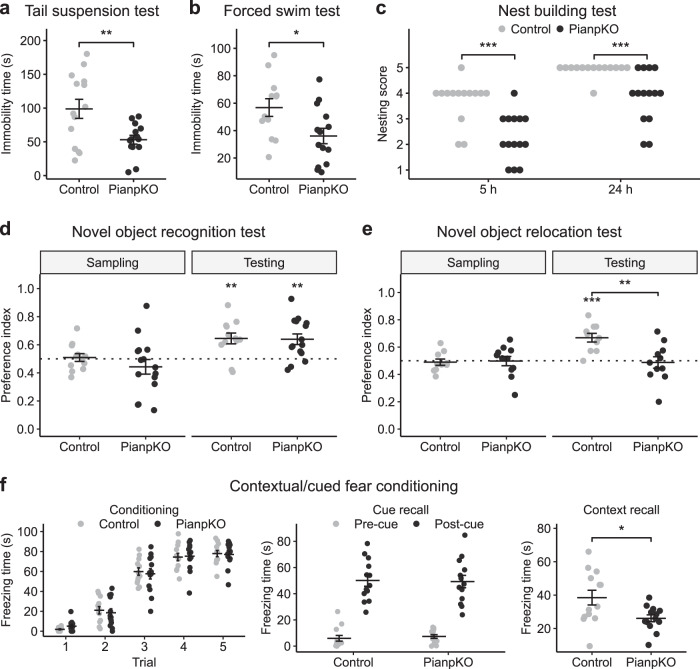Fig. 4.
Pianp-deficient mice show an increased response to acute stress, a lower nesting score, no preference for a relocated object, and a deficit in contextual fear conditioning. a In the tail suspension test (TST), PianpKO mice (n = 14) moved more and had a significantly shorter time of immobility (t(26) = 2.93, p < 0.01) compared with control mice (n = 14). b In the forced swim test (FST), PianpKO mice (n = 14) swam for a longer time and had a significantly shorter time of immobility (t(24) = 2.44, p < 0.05) compared with control mice (n = 12). c In the nest building test (NBT), PianpKO mice (n = 14) had significantly lower nesting scores compared with the controls (n = 12) in the nest building after 5 h (U = 170.5, p < 0.001) and 24 h (U = 163, p < 0.001). d In the novel object recognition test (ORT), PianpKO (n = 15) (sampling: t(14) = 1.10, p > 0.05; testing: t(14) = 3.71, p < 0.01) and control mice (n = 12) (sampling: t(11) = 0.33, p > 0.05; testing: t(11) = 3.76, p < 0.01) showed a similar preference for the novel object that did not differ between the two groups (sampling: t(25) = 1.05, p > 0.05, testing: t(25) = 0.11, p > 0.05). e In the object relocation test (ORL), control mice (n = 10) showed a preference for the relocated object (sampling: t(9) = 0.45, p > 0.05; testing: t(9) = 5.30, p < 0.001) while PianpKO (n = 11) did not show a preference for the relocated object (sampling: t(10) = 0.06, p > 0.05; testing: t(10) = 0.29, p > 0.05). The preference index differed significantly between the two groups in the testing phase (sampling: t(19) = 0.20, p > 0.05; testing: t(19) = 3.38, p < 0.01). f In the contextual and cued fear conditioning, PianpKO mice (n = 12) and control mice (n = 13) showed a successful conditioning and comparable cue recall (t(24) = 0.13, p > 0.05). In context recall, however, PianpKO had a significantly lower freezing time (t(24) = 2.55, p < 0.05). Horizontal lines indicate mean ± SEM. *p < 0.05, **p < 0.01, ***p < 0.001, a, b two-tailed unpaired t-test, c Mann–Whitney U test, d, e one sample or two-tailed unpaired t-test

